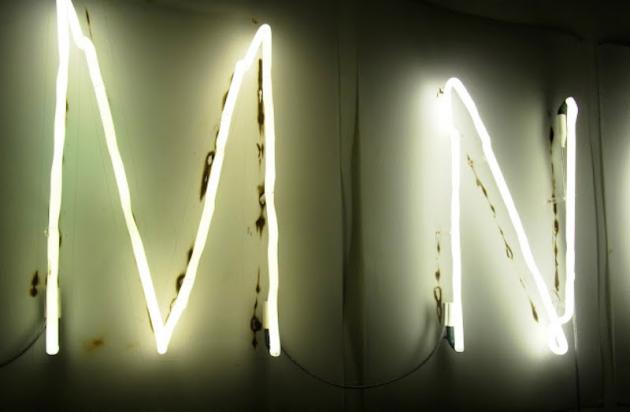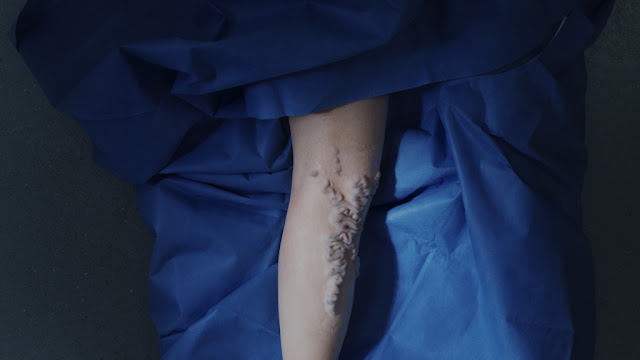In his rolling reviews of the must see art exhibitions in London critic Paul Carey-Kent looks at what’s on around the capital.
Fiona Banner: Study #13. (Top Photo) Every Word Unmade @ David Roberts Art Foundation, Symes Mews – Mornington Cresent
To 5 March: http://davidrobertsartfoundation.com
Every Word Unmade, 2007: 26 neon parts bent by the artist, paper templates, clamps, wire, and transformers 70 x 100 cm each
Pretty often I reckon I’ve seen enough neon, but Fiona Banner – though not greatly associated with the medium – uses it freshly as part of what proves to be a concise retrospective in the guise of DRAF’s study programme. Her first, Neon Full Stop (1997), is wittily minimal and maximal at once, a breath encapsulated in glass which prefigures her move to big, shaped full stops – present here as bean bags. Every Word Unmade(2007) is a large and stutteringly clunky white neon alphabet ready to create meaning. It was checked against the paper templates on which the letters were drawn, causing rather alluring burn marks. Beagle Punctuation (2011) turns punctuation marks into Snoopy. The Vanity Press (2013) is an ISBN number published as a book with that reference under Banner’s own imprint.
 Neon Full Stop, 1997 – Neon, wire, transformer, wooden box
Neon Full Stop, 1997 – Neon, wire, transformer, wooden box
______________________
Marie Jeschke: Can’t Remember Always Always @
l’étrangère, 44a Charlotte Rd – Shoreditch
 ‘Kieshofer Moor, Always’
‘Kieshofer Moor, Always’
Berlin-based Marie Jeschke goes against gender stereotypes by using blown-up versions of collectible football stickers as the most prominent aspect of her main installation: they are shaped into the form of familial symbols – dating back to pre-literate times – from Heddensee Island in Northern Germany, still used as signs on houses. That suggests one form of social identity usurping another, and Jeschke makes it personal by mounting the images on her grandfather’s images of the moors nearby, A similar back and forth features in a second room in which she immerses photographs of childhood scenes she says she’s forgotten in tanks of liquids from her current life to activate the past through the distortions of the present.
 ‘Can’t Remember Always Always’, with photos in liquids at front, bottles of liquids at right, processed photos behind
‘Can’t Remember Always Always’, with photos in liquids at front, bottles of liquids at right, processed photos behind
______________________
Mykola Ridnyi: Under Suspicion @ Edel Assanti, 74a Newman Street – Fitzrovia
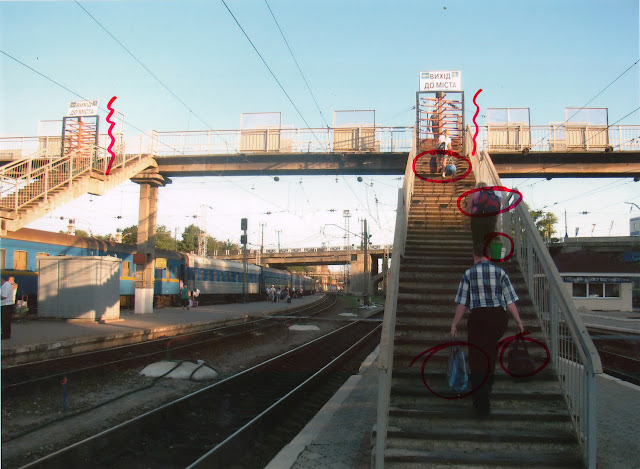 From Under suspicion, slide projection of 33 frames, 2015
From Under suspicion, slide projection of 33 frames, 2015
Upstairs at Edel Assanti is like a warzone, but is actually just Jesse Hlebo’s dark and noisy curation. Downstairs is quieter and more measured… but we’re in Kharkiv, which really was on the verge of the war on the East of Ukraine, courtesy of one of the nations leading artists, Mykola Ridnyi. In Regular Places the camera is static, the city calm – but the soundtrack periodically bursts into the protests and violence which took place six months earlier. Under Suspicion lays bare the Government’s paranoia through photographs which imitate police archives by applying literally the instructions in official leaflets about what to take seriously as a terror threat – ie circling pretty much everything of interest. But as we know, being paranoid doesn’t mean they’re not out to get you.
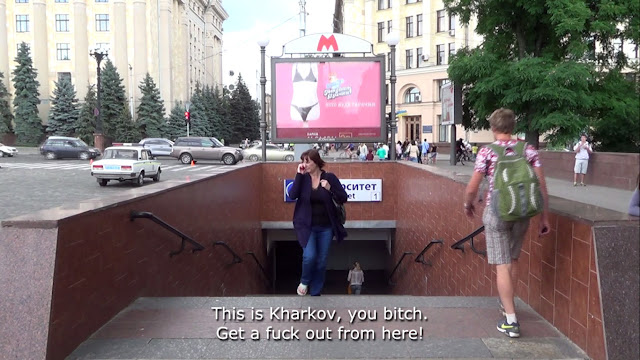 Still from Regular places, HD video, 15:23 min., 2014-2015
Still from Regular places, HD video, 15:23 min., 2014-2015
______________________
James Brooks: Geometra @ Canal, 60 De Beauvoir Crescent – Haggerston
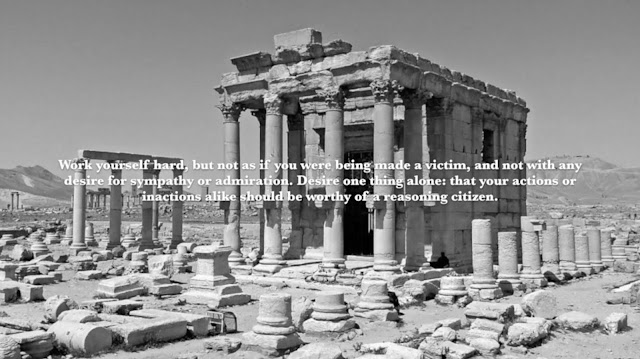
Still from Stoic Meditations of Marcus Aurelius, 2016
James Brooks’ subtle drawing-originated practice delights in using coded realities as the basis for apparent abstraction, and the seven methodological strands of Geometra also link the classical world to contemporary communications and terrorism. The result is the simplest-seeming complex show you could wish for. The audio slideshow Stoic Meditations of Marcus Aurelius combines three elements: seven black and white images of Syrian ruins as they were before the current conflict; seven selections from the ancient text chosen for resonance in the context; and a musical score for harp and flute derived from the sequencing of letters in the quotes. We’re flickering between chance and calamity, yet the 22 minute whole is ambiently meditative.
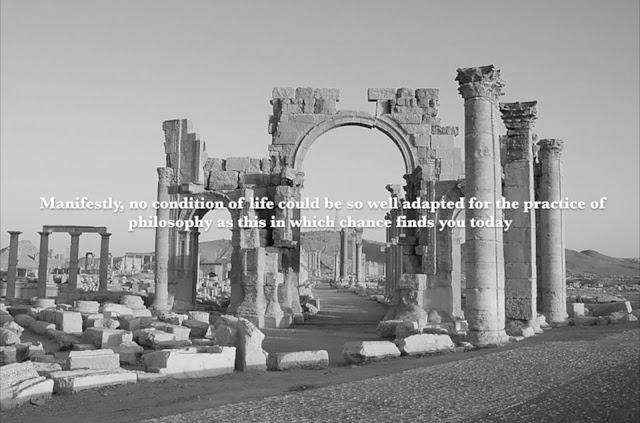
Still from Stoic Meditations of Marcus Aurelius, 2016
______________________
Nathaniel Rackowe: The Luminous City @ Lobby One Canada Square – Canary Wharf
To 12 Feb: www.canarywharf.com
 The Consequence of Light, 2015, at Canary Wharf
The Consequence of Light, 2015, at Canary Wharf
London is been ablaze with light art. Nathaniel Rackowe features in the centrally Lumiere London, complements the Winter Lights show at Canary Wharf, and also has an external piece near Berkeley Square. Rackowe’s work – essentially a re-purposing of urban architectural elements as art and half the way back again – may not be ideally placed in a marbled corporate lobby, but is strong enough to assert itself. There are expanded and collapsed versions of a shed lit from within, a construction to be complemented by dancers, and the kineticThe Consequence of Light, in which the rise and fall of 48 neon tubesmakes for a surprisingly epiphanic evocation of sunrise and sunset. Another innovation is the use of dichroic glass, also seen at Hay Hill. It contains no pigment but takes on different hues from different angles due to coverings of ultra-thin metal crystals.
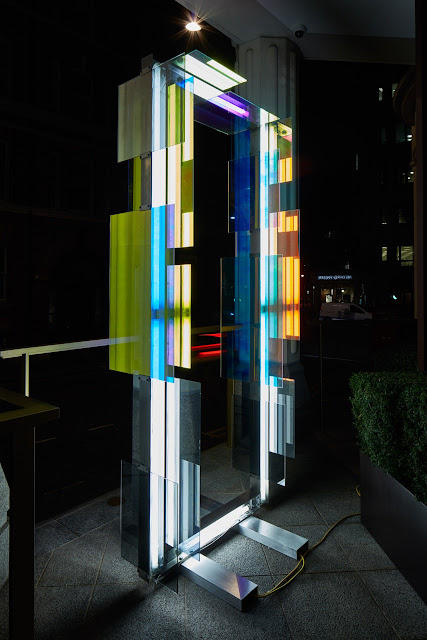 Portal, 2015, outside the 12 Hay Hill Club
Portal, 2015, outside the 12 Hay Hill Club
______________________
Marianna Simnett: Valves Collapse @ Seventeen, 270-276 Kingsland Rd – Haggerston
Varicose veins and hyperventilation are the unlikely main subjects of Marianna Simnett’s striking show. The former are tackled by both surgery and remote-controlled cockroaches in the repulsively inviting film Blue Roses. Simnett has performed the latter to the point of fainting: here the soundtrack derived from such actions controls the pulses of light in the 10 minute cycle of the installation Faint with Light,built onsite. The relentless anxiety generated put me in mind of Tony Ousler, but without image or words being necessary – the most economically aggressive use of white light I can recall since Alfredo Jaar’s Lament of the Images, 2002.
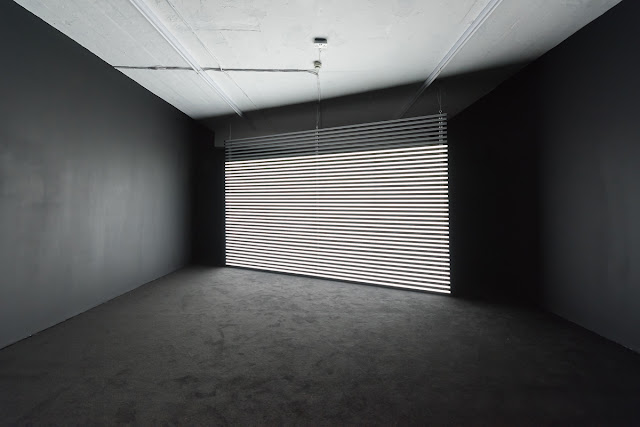 Faint with Light, 2016
Faint with Light, 2016
______________________
Julia Wachtel @ Vilma Gold and in Champagne Life @ Saatchi Gallery
To 13 Feb (Gold) / 9 March (Saatchi)
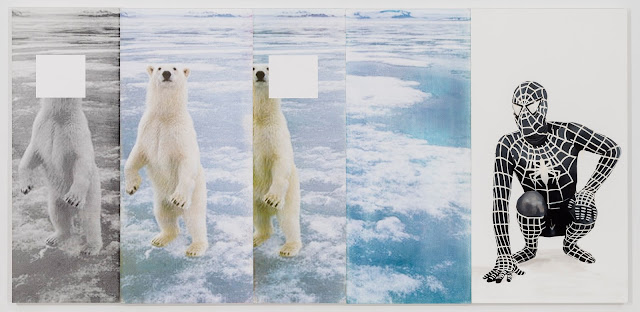 Hero, 2015 oil, flashe, lacquer ink on canvas, 152.5 x 320 cm
Hero, 2015 oil, flashe, lacquer ink on canvas, 152.5 x 320 cm
You have two chances to see recent work by Julia Wachtel, an American associated with the ‘Pictures Generation’ who has since the 1980’s been exploring how our take on images appropriated from popular culture can be affected by repetition, juxtaposition, changes of scale and clashes of register – in ways which predated the Internet but now feed off it. Each multi-panel work combines painted and digital realisations of her sources to further complicate the status of what we see. To take one example from each show, Landscape No. 19 (Witness), 2014, shows her typical use of cartoon characters from greeting cards to puncture the psychology of a scene. Hero, 2015, suggests that even a superhero – let alone one sourced from a fancy dress catalogue – is helpless in the face of the global warming represented by a stranded polar bear.
 Landscape No19 (Witness). 2014 – Oil, flashe and acrylic ink on canvas, 6 panels, overall: 152 x 325 cm
Landscape No19 (Witness). 2014 – Oil, flashe and acrylic ink on canvas, 6 panels, overall: 152 x 325 cm
________________________________
Leipzig Unfolding @ Lloyds Club, 42 Crutched Friars – Tower Hill
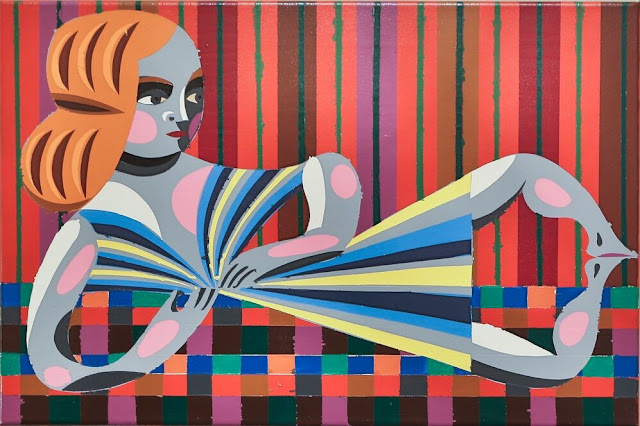 Christoph Ruckhäberle: Netsuke 19, 2015 – enamel on canvas, 40 x 60 cm
Christoph Ruckhäberle: Netsuke 19, 2015 – enamel on canvas, 40 x 60 cm
A spacious city lunch club provides the unusual location for a 50 work primer of current trends out of Liepzig’s Hochshule fur Grafik und Buchkunst, which has a track record for producing painters. The fifteen artists chosen by curator Lavinia Feitas studied with such forbears as Bernhard Hesig, Arno Rink and Neo Rauch. Christoph Ruckhäberle, perhaps the best-known name, shows small scale but high impact enamels of his decoratively posed figures. Rosa Loy, Tilo Baumgartel and Hans Aichinger provide more of the mysterious cross-historical figuration associated with the Leipzig School, but there’s plenty else: Henriette Grahnert’s jokes about abstraction; Claus Georg Stabe’s ethereally obsessive biro drawings; Martin Gross’s intricately gridded woodblock overprintings; Thomas Sommer’s landscape dioramas…
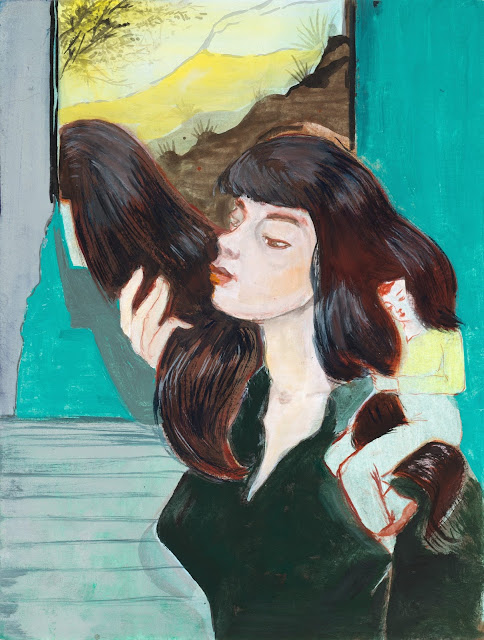 Rosa Loy: Tuft, 2013 – casein on paper, 40 x 30 cm
Rosa Loy: Tuft, 2013 – casein on paper, 40 x 30 cm
________________________________
Frame thy Fearful Symmetry @ Collyer Bristow Gallery, 4 Bedford Row – Holborn
To 24 Feb 2016 (weekdays, by appointment): www.collyerbristow.com
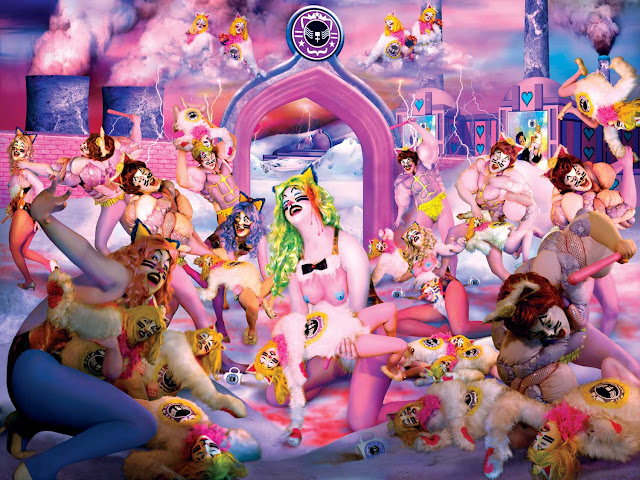 Rachel Maclean: The Massacre of the Innocents, 2011
Rachel Maclean: The Massacre of the Innocents, 2011
Curatorial duo Hi Barbara’s choices for the unusual location of lawyers’ offices combine a witty shelf of Richard Wentworth prints with a younger generation of photo-based interdisciplinary artists – Ruth Proctor, Tom Lovelace, David Raymond Conroy, Eva Stenram, Rachel Maclean and Tina Hage – who reframe reality through performance, construction, re-presentation and manipulation. For example, those last two present themselves as the sole actor to contrasting effect; Stenram shows new twists on the questionable but compelling, quaint yet dark voyeurism she extracts from rephotographing and digitally altering sixties glamour shots; artist and ice skating coach Proctor documents her attempts to land the jumps she could nail in her competitive prime, opening up the possibility of failing better – if that’s what falling more often makes for – as she grows older.
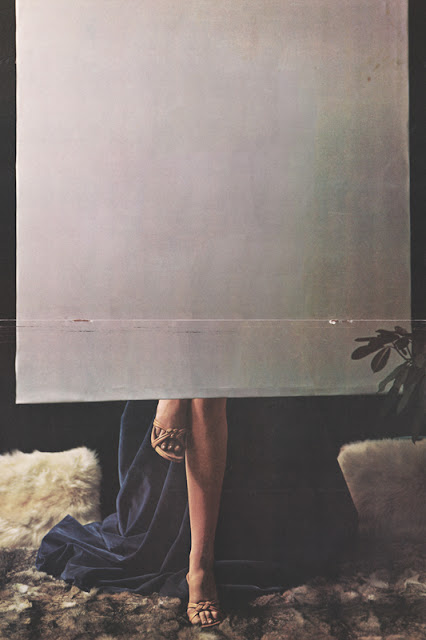 Eva Stenram: Drape (Centrefold II), 2012
Eva Stenram: Drape (Centrefold II), 2012
._________________________
Mark Davey: Blend @ The Ryder, 19a Herald St – Bethnal Green
 ‘Hold’, 2015 Painted steel, fluorescent lights, chain-link fence, stainless steel 73 cm x 60 cm
‘Hold’, 2015 Painted steel, fluorescent lights, chain-link fence, stainless steel 73 cm x 60 cm
It’s a good time to visit the five galleries on the Herald Street block: several strong shows include such original turns as Kaye Donachie’s face-off of painting and cyanotype at Maureen Paley and Simon Fujiwara’s shaved fur coats at Laura Bartlett. Nor is the newest of them outclassed: The Ryder’s garage-with-door space proves well suited to Mark Davey’s industrial yet corporeal sculptures, which bring human hesitancy to the mechanical as they trace a neo-romantic path around the walls: from the hypnotic rise and catch of the pair of anthropomorphised neon tunes which constitute Us; to the chain-link and light of Hold (for which, Davey says, he chose two of the 400 available colours of plastic filters) to the poignant dual simplicity of After You Left.
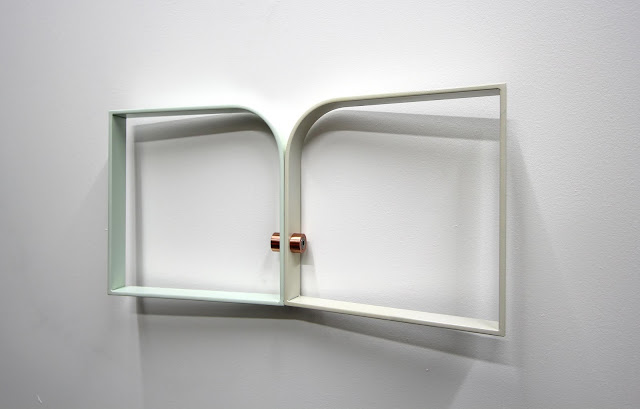 ‘After You Left’, 2015 Painted steel and copper 22 cm x 42 cm
‘After You Left’, 2015 Painted steel and copper 22 cm x 42 cm
Tags
London Art Exhibitions,
Pul carey-kent  Neon Full Stop, 1997 – Neon, wire, transformer, wooden box
Neon Full Stop, 1997 – Neon, wire, transformer, wooden box ‘Can’t Remember Always Always’, with photos in liquids at front, bottles of liquids at right, processed photos behind
‘Can’t Remember Always Always’, with photos in liquids at front, bottles of liquids at right, processed photos behind From Under suspicion, slide projection of 33 frames, 2015
From Under suspicion, slide projection of 33 frames, 2015 Still from Regular places, HD video, 15:23 min., 2014-2015
Still from Regular places, HD video, 15:23 min., 2014-2015 
The Consequence of Light, 2015, at Canary Wharf
 Portal, 2015, outside the 12 Hay Hill Club
Portal, 2015, outside the 12 Hay Hill Club Faint with Light, 2016
Faint with Light, 2016 Hero, 2015 oil, flashe, lacquer ink on canvas, 152.5 x 320 cm
Hero, 2015 oil, flashe, lacquer ink on canvas, 152.5 x 320 cm Landscape No19 (Witness). 2014 – Oil, flashe and acrylic ink on canvas, 6 panels, overall: 152 x 325 cm
Landscape No19 (Witness). 2014 – Oil, flashe and acrylic ink on canvas, 6 panels, overall: 152 x 325 cm Christoph Ruckhäberle: Netsuke 19, 2015 – enamel on canvas, 40 x 60 cm
Christoph Ruckhäberle: Netsuke 19, 2015 – enamel on canvas, 40 x 60 cm Rosa Loy: Tuft, 2013 – casein on paper, 40 x 30 cm
Rosa Loy: Tuft, 2013 – casein on paper, 40 x 30 cm  Rachel Maclean: The Massacre of the Innocents, 2011
Rachel Maclean: The Massacre of the Innocents, 2011 Eva Stenram: Drape (Centrefold II), 2012
Eva Stenram: Drape (Centrefold II), 2012 ‘Hold’, 2015 Painted steel, fluorescent lights, chain-link fence, stainless steel 73 cm x 60 cm
‘Hold’, 2015 Painted steel, fluorescent lights, chain-link fence, stainless steel 73 cm x 60 cm ‘After You Left’, 2015 Painted steel and copper 22 cm x 42 cm
‘After You Left’, 2015 Painted steel and copper 22 cm x 42 cm 
